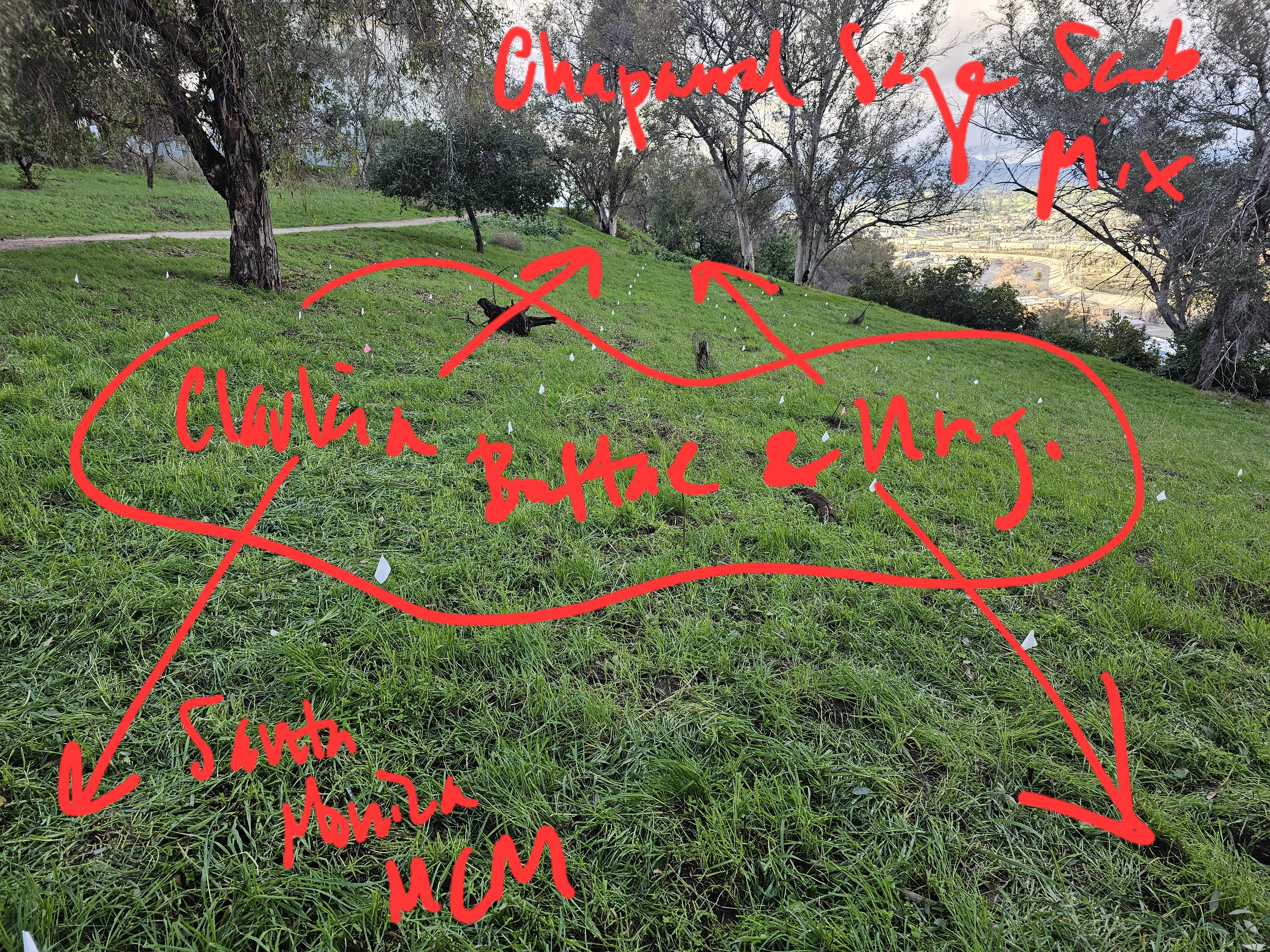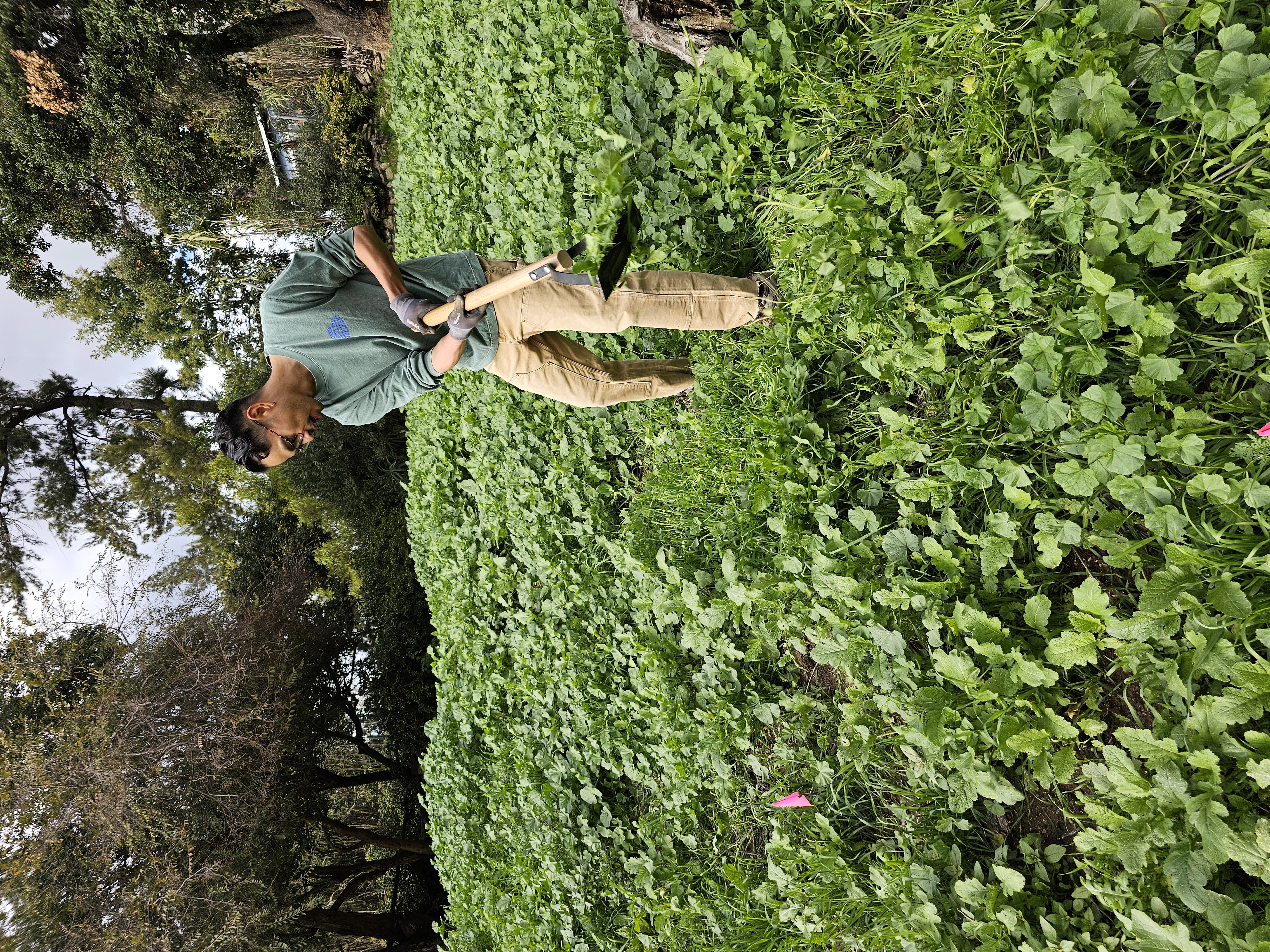DISTURBANCE
Elysian Test Plot
By Jenny Jones
Test Plot Co-Founder, Terremoto Partner
Elysian Test Plot
By Jenny Jones
Test Plot Co-Founder, Terremoto Partner
DATE: July 08 2024
This post is long overdue. I kept meaning to write, but each time I was ready to document the latest events in the plots, something exciting would happen. Or, something devastating—making it hard to write an objective update without being clouded by emotion. But time has passed, dust has settled, and hopefully this entry has just the right amount of both objectivity and heart.
We started the year extremely hopeful, bolstered by the success of the Rainbow River and our experiments with seed in 2023. We planned to expand the Rainbow River with wildflowers from seed, but also created a new plot, our biggest one yet, to test establishing shrubs from seed. We call this new area the Row Plots, as we decided to lay out the plots into agricultural rows, to make for ease of weeding and management. The Row Plots are also a nice foil to the snaking form of the Rainbow River.
The first seeding of the season started very organically: we were simply inspired by the beautiful tufts of seedheads that were proliferating on our goldenbush, goldenrod, and coyote bush plants within the existing plots. One original dream of the Test Plots at Elysian was for them to serve as seed sources for further expansion of native ecologies, outward from the plots. This past fall, it was obvious that the plots were ready to play this role. The seedheads were calling to us, and were just begging to be cast around. Over a series of weeks when I was at the park alone, on a daily walk, I would stop at the plots, and simply break the branches of the bountiful plants. Then I would walk the adjacent hillsides, beating the branches together to dislodge and spread the seed. I felt like a true plant witch, casting spells with my wands, sending dreamy drifts of seeds floating through the air. It was easy, free, joyful work.



Then we got a little more serious and made our plans. We re-seeded the Rainbow River, unable to let ourselves be patient and see if it would reseed itself. It was simply too beautiful last year to not do it again. Maybe next year we’ll hold back and see what comes up on its own. We also laid out the Row Plots, and used flags to carefully mark both seeded areas. While the Rainbow River was about putting on a show of wildflowers, in the Row Plots, we seeded mostly shrub species. We dappled in some clarkia and poppies for a little splash of color in the first year. The rains blessed us big time this year, and our adorable seedlings quickly started coming up.
![]()
![]()


Enter the first setback. One day in February we showed up to work at the plots, to weed among the seedlings. And we found every single one of the hundreds of flags we had laid out, simply gone. We were confused for a bit, wondering if possibly Rec and Parks didn’t like what we were doing this year and had intervened. But then we found all the flags, along with some lovely hand-painted signs we had made, all thrown down the hill scattered in the brush. We still haven’t found the logic in this act, as none of the plants themselves were damaged. All of our work was technically still intact, which was a relief, but it still felt like a violation, nonetheless. We collected the flags we could reach, some of us getting poison oak in the process, and we re-placed the flags as best we could. And kept going.
In March we held several events to bring in and train new volunteers. It was heartwarming to see so many folks come out to lovingly tend to the seedlings, pulling invasive grass and mustard by hand to allow the wildflowers a chance to compete. In addition to hand-weeding, we did a lot of scything this year. We had been experimenting with simple hand-mowers for a few years, but this year Terremoto acquired two real scythes, and we sure had a lot of fun with them. We decided to scythe all around the Rainbow River, thinking it might just be helpful to slowly beat back the mustard and interrupt is cycle of going to seed. We also used the scythes in the Row Plots, both to do the initial site clearing, as well as to keep the weeds between the rows in check. We found that the scything is indeed helpful, and gets a lot of work done in a short amount of time. We also found success in the Row Plots with scything as the only site prep. When timed perfectly before a big rain, no other soil or site prep was needed to see seedlings come up and compete with the invasives. This bodes well for expanding, getting more seedlings established at a larger scale throughout the park, because the labor inputs are fairly low.



By April we had blooms coming along nicely, and we kept weeding out the grass and mustard. Critters started appearing on the blooms, butterflies, bees, flies, and moths. We suffered another little setback when someone decided to walk through the Rainbow River, leaving a little path of destruction in their wake. We decided to not assume it was intentional, and we simply adjusted some of the wood stakes we had out there marking where to walk across the river. We propped some of the seedlings back up and hoped they’d bounce back. The Row Plots were a few weeks behind the Rainbow River in terms of growth, a mixture of slightly later seeding and the fact that they are on a north-facing slope.
![]()
![]()
![]()
![]()




When May came, so did the flowers. The Rainbow River seemed to pop overnight, into a technicolor array of blooms: Owl’s Clover, Phacelia, Poppies, Lupines, Chia, and of course Clarkia. This year we added in Clarkia bottae that we had collected from the next ridge over in Elysian Park. It’s a tall, striking Clarkia with flowers that are perfectly freckled with dark pink spots. We hope to do even more seed collection from around the park this fall. This year did not bring the massive amount of White Lined Sphinx Moth Caterpillars that we saw in 2023. We did see a few, but nothing like the hundreds if not thousands that were on the Rainbow River last year. We can’t say whether that was just nature’s way, or whether it’s because we did something different. We can’t control all the variables at the plots, and we’re ok with that. We still worshipped the few that showed up.



Then on the morning of May 22nd, I went to check on the blooms, and saw that the Rainbow River had been trampled. I was devastated. I wondered if there’s any way it could have been coyotes having a romp, or someone accidentally walking through at night when they couldn’t see. But then I noticed that all the flags in the Row Plots were gone again, and my only conclusion was that it was another intentional act of vandalism. My heart was broken at the thought of someone deciding to trample all those heavenly beings. After all the hours and hours of loving care that dozens of people put into bringing these wildflowers into the world, over months and months, one person in one night trampled it all. I couldn’t understand, and I was angry.
But I called Jen Toy, who kindly commiserated with me, but then also wisely reminded me that we are working in an urban park, where realities like this are inevitable. She reframed this event as simply one of Disturbance, just another Test for us. Once that sank in, I calmed down and was able to see the trampling as an event to witness and to work with, not one to get defeated by. I moved through the sadness to see the good: that our Row Plots were still coming in, and miraculously hadn’t been damaged; that all of our original plots with fencing were unharmed and were in full glory of flower and abundance; and that actually, people walking through the park were still stopping to tell me how beautiful the flowers were, even though they were now lying down on the ground, broken and withering. And in fact, the bees were still visiting them.
However there was more Disturbance to come. A few weeks later, the brush clearance crews swept through the park. Despite the fact that we had already cleared most everything with scythes, the weed whackers still came through and went scorched earth on the land. A saving grace for me after the flower trampling was that there were still many tiny goldenbush and coyote bush seedlings that were coming up all over. But the crews came through and cut down everything in their path, unless we had a fence around it, or there was a flag marking it. I realized when I witnessed the crews doing this, how very violent and counterproductive this annual brush clearance is. Any tiny native that tries to come up in the spring is destined to get mowed down, essentially maintaining the park as a constantly disturbed site where no native ecology is allowed to live. Not to mention the countless birds, insects and small mammals whose lives are disrupted or destroyed when an army of men with machines tear through the park. Rec and Parks should be caring for the park, not inflicting this violence upon the land. Their brush clearance this year has upset other community members as well, when they destroyed a beloved children’s garden that was full of mature native plants, all in the name of fire safety.
So.
What can we do? We’re trying to help regenerate an urban park that suffers from constant vandalism and violence, from without and within. We plan to speak with our coalition of concerned community members to see what we can change with the overall management of the park. We have a proposal brewing for a pilot project of turning brush clearance duty in and around the plots over to our coalition of community groups. Although we were hoping to be able to not always need fences at Elysian, we’ve learned the hard way that the plants need protection. The disturbance we experienced this winter has lit a fire in our bellies, and we are planning to go even bigger with our scything and seeding work in the years to come.
And as it turns out, a few of the goldenbush that were whacked down are actually still alive, eager to persist. We’ve marked them, protected them, and are watering them this summer. We will keep going with our steady acts of care, moving slowly, gently, and lovingly, inspired by the resilience and persistence of our beloved California plants.


